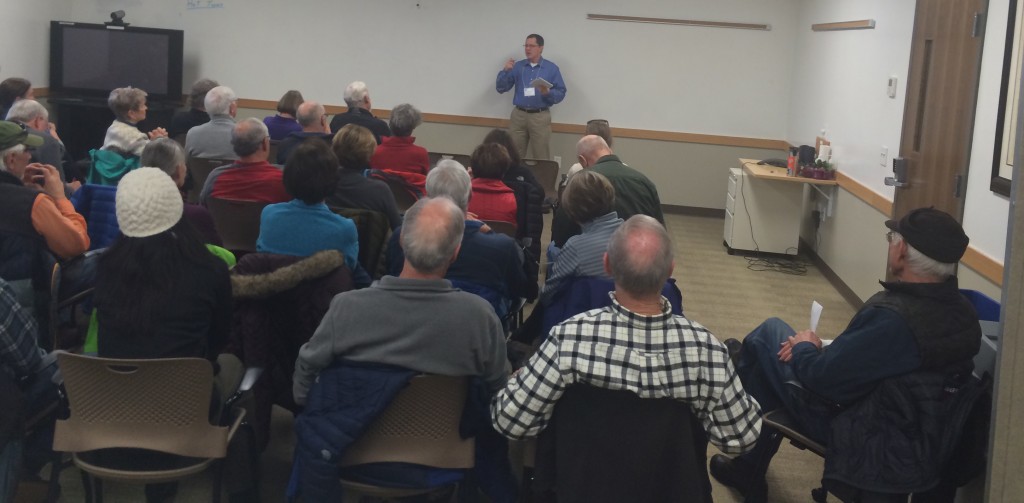
Dan Slanina of Federal Highways in Seattle explains the Warren Wagon Road repaving project to a packed room of concerned citizens at the Payette National Forest headquarters in McCall. Thanks to everyone for showing up!
On Tuesday, Jan. 10, we had a great turnout in McCall for two public meetings about planned improvements to Warren Wagon Road, despite a steady downpour of snow that day in Valley County, and horrible driving conditions in Boise that caused most schools to close.
Even so, people concerned about bicycle and pedestrian safety came to the meetings to encourage Federal Highways officials from Seattle to maximize on the width of bike lanes as much as possible.
Dan Slanina, project manager, gave a presentation about the $11 million project, indicating that Federal Highways understands the priority for bicycle/pedestrian safety and built in 3-foot shoulders on both sides of the road in their latest design. Previously, they had designed a 1-foot shoulder and indicated that wider shoulders would be too expensive.
So BIG KUDOs to FWHA folks for getting the message!
Some basics about the project: It would extend 5.5 miles along Warren Wagon Road from the end of the existing bike lanes, past North Beach, to the junction with Eastside Drive. FHWA plans field work in May to develop a 70% design for the project, at which time they will hold another public meeting. Final design would occur in late fall, and construction is expected to begin in 2018. They expect the project to take 2 years to build.
Existing bike lanes on Warren Wagon Road and in McCall are built to a 4-foot standard, so Slanina said FWHA analyzed the potential cost of going 1 foot wider on both sides of the road. He said that option would essentially double the cost because going any wider would require blasting and cutting away granite rock cliffs next to the mountain along the road. Valley County officials don’t want to go that route. We agree that cutting into the cliffs would not only make the project cost-prohibitive, it would create a long-term maintenance nightmare.
I asked Slanina about the possibility of designing a project that incorporated 4-foot bike lanes where possible – without cutting into the granite cliffs – and going with 3-foot shoulders otherwise. He said FHWA would look at that alternative and see how many linear feet might qualify for a wider shoulder and how much more it might cost. VC Pathways intends to pursue this option with vigor.
Several other people who attended the meeting recommended a similar “compromise” that would further the cause of pedestrian/bike safety and make people more comfortable on a wider shoulder where possible.
A single 6-foot pathway? VC Pathways associate Andy Olavarria asked about combining the two 3-foot shoulders and creating a 6-foot path on one side of the road. Slanina said FHWA could look at that, but he thought that approach had issues … with bicyclists riding the wrong way against traffic, it’d be too narrow for two-way pedestrian traffic (most detached pathways are 8-foot minimum), and there’d be no way to separate the 6-foot lane because motorists still would need a shoulder to pull off the road in the event of an accident or vehicle breakdown.
We talked about using pylons or a raised curb to separate the lane, but both of those options would present issues for snowplows in the winter, according to Valley County road department officials.
Valley County Commissioner Gordon Cruickshank noted that everyone would favor a separate detached pathway, but the limited right of way, constrained by the lake on one side and granite cliffs on the other, isn’t wide enough for a detached pathway. Slanina also had covered that point.
Other suggestions included narrowing the traffic lanes from 11 feet to 10 feet (normal width is 12). FHWA already had narrowed the traffic lanes to 11 feet to provide more shoulder, but if you went to 10-foot lanes, that would require a minimum 25 mph speed limit for the length of the project, said Jeff McFadden, Valley County Road Superintendent. In my mind, the 25 mph speed limit would anger too many people, and create a speed trap.
Cruickshank said a 10-foot lane would be too narrow for trucks pulling trailers, too.
The bottom line: VC Pathways will advocate for 4-foot shoulders where possible and see if that is feasible from a cost perspective. We also will work with FHWA to encourage plenty of signage along the route to make it clear that motorists need to “Share the Road,” and use bicycle stencils on the roadway as well.
People attending the meeting were given forms to fill out to provide their input on the project. If you’d like to send in a comment, please send an email to Dan Slanina [email protected], or Erin Chipps, [email protected]. Please endorse our position in this matter. If you have any other ideas, please let us know!
– Steve Stuebner, Valley County Pathways

Comments are closed